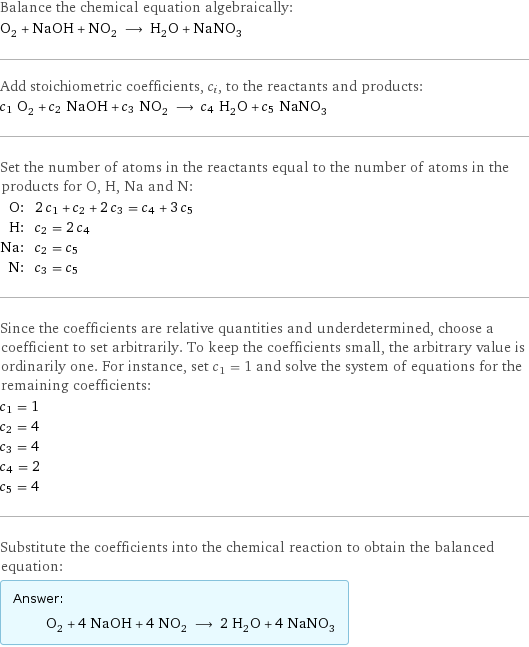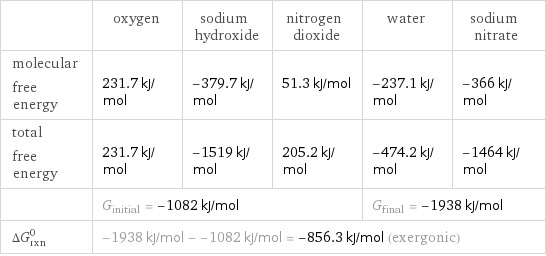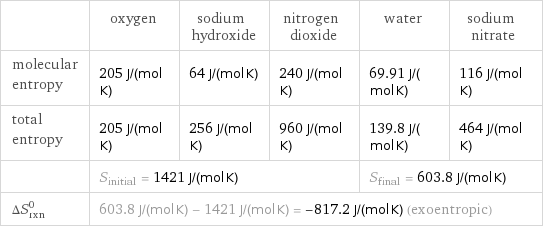Input interpretation

O_2 oxygen + NaOH sodium hydroxide + NO_2 nitrogen dioxide ⟶ H_2O water + NaNO_3 sodium nitrate
Balanced equation

Balance the chemical equation algebraically: O_2 + NaOH + NO_2 ⟶ H_2O + NaNO_3 Add stoichiometric coefficients, c_i, to the reactants and products: c_1 O_2 + c_2 NaOH + c_3 NO_2 ⟶ c_4 H_2O + c_5 NaNO_3 Set the number of atoms in the reactants equal to the number of atoms in the products for O, H, Na and N: O: | 2 c_1 + c_2 + 2 c_3 = c_4 + 3 c_5 H: | c_2 = 2 c_4 Na: | c_2 = c_5 N: | c_3 = c_5 Since the coefficients are relative quantities and underdetermined, choose a coefficient to set arbitrarily. To keep the coefficients small, the arbitrary value is ordinarily one. For instance, set c_1 = 1 and solve the system of equations for the remaining coefficients: c_1 = 1 c_2 = 4 c_3 = 4 c_4 = 2 c_5 = 4 Substitute the coefficients into the chemical reaction to obtain the balanced equation: Answer: | | O_2 + 4 NaOH + 4 NO_2 ⟶ 2 H_2O + 4 NaNO_3
Structures

+ + ⟶ +
Names

oxygen + sodium hydroxide + nitrogen dioxide ⟶ water + sodium nitrate
Reaction thermodynamics
Enthalpy

| oxygen | sodium hydroxide | nitrogen dioxide | water | sodium nitrate molecular enthalpy | 0 kJ/mol | -425.8 kJ/mol | 33.2 kJ/mol | -285.8 kJ/mol | -467.9 kJ/mol total enthalpy | 0 kJ/mol | -1703 kJ/mol | 132.8 kJ/mol | -571.7 kJ/mol | -1872 kJ/mol | H_initial = -1570 kJ/mol | | | H_final = -2443 kJ/mol | ΔH_rxn^0 | -2443 kJ/mol - -1570 kJ/mol = -872.9 kJ/mol (exothermic) | | | |
Gibbs free energy

| oxygen | sodium hydroxide | nitrogen dioxide | water | sodium nitrate molecular free energy | 231.7 kJ/mol | -379.7 kJ/mol | 51.3 kJ/mol | -237.1 kJ/mol | -366 kJ/mol total free energy | 231.7 kJ/mol | -1519 kJ/mol | 205.2 kJ/mol | -474.2 kJ/mol | -1464 kJ/mol | G_initial = -1082 kJ/mol | | | G_final = -1938 kJ/mol | ΔG_rxn^0 | -1938 kJ/mol - -1082 kJ/mol = -856.3 kJ/mol (exergonic) | | | |
Entropy

| oxygen | sodium hydroxide | nitrogen dioxide | water | sodium nitrate molecular entropy | 205 J/(mol K) | 64 J/(mol K) | 240 J/(mol K) | 69.91 J/(mol K) | 116 J/(mol K) total entropy | 205 J/(mol K) | 256 J/(mol K) | 960 J/(mol K) | 139.8 J/(mol K) | 464 J/(mol K) | S_initial = 1421 J/(mol K) | | | S_final = 603.8 J/(mol K) | ΔS_rxn^0 | 603.8 J/(mol K) - 1421 J/(mol K) = -817.2 J/(mol K) (exoentropic) | | | |
Equilibrium constant
![Construct the equilibrium constant, K, expression for: O_2 + NaOH + NO_2 ⟶ H_2O + NaNO_3 Plan: • Balance the chemical equation. • Determine the stoichiometric numbers. • Assemble the activity expression for each chemical species. • Use the activity expressions to build the equilibrium constant expression. Write the balanced chemical equation: O_2 + 4 NaOH + 4 NO_2 ⟶ 2 H_2O + 4 NaNO_3 Assign stoichiometric numbers, ν_i, using the stoichiometric coefficients, c_i, from the balanced chemical equation in the following manner: ν_i = -c_i for reactants and ν_i = c_i for products: chemical species | c_i | ν_i O_2 | 1 | -1 NaOH | 4 | -4 NO_2 | 4 | -4 H_2O | 2 | 2 NaNO_3 | 4 | 4 Assemble the activity expressions accounting for the state of matter and ν_i: chemical species | c_i | ν_i | activity expression O_2 | 1 | -1 | ([O2])^(-1) NaOH | 4 | -4 | ([NaOH])^(-4) NO_2 | 4 | -4 | ([NO2])^(-4) H_2O | 2 | 2 | ([H2O])^2 NaNO_3 | 4 | 4 | ([NaNO3])^4 The equilibrium constant symbol in the concentration basis is: K_c Mulitply the activity expressions to arrive at the K_c expression: Answer: | | K_c = ([O2])^(-1) ([NaOH])^(-4) ([NO2])^(-4) ([H2O])^2 ([NaNO3])^4 = (([H2O])^2 ([NaNO3])^4)/([O2] ([NaOH])^4 ([NO2])^4)](../image_source/51e7851ad0c291b81d786062affce9e0.png)
Construct the equilibrium constant, K, expression for: O_2 + NaOH + NO_2 ⟶ H_2O + NaNO_3 Plan: • Balance the chemical equation. • Determine the stoichiometric numbers. • Assemble the activity expression for each chemical species. • Use the activity expressions to build the equilibrium constant expression. Write the balanced chemical equation: O_2 + 4 NaOH + 4 NO_2 ⟶ 2 H_2O + 4 NaNO_3 Assign stoichiometric numbers, ν_i, using the stoichiometric coefficients, c_i, from the balanced chemical equation in the following manner: ν_i = -c_i for reactants and ν_i = c_i for products: chemical species | c_i | ν_i O_2 | 1 | -1 NaOH | 4 | -4 NO_2 | 4 | -4 H_2O | 2 | 2 NaNO_3 | 4 | 4 Assemble the activity expressions accounting for the state of matter and ν_i: chemical species | c_i | ν_i | activity expression O_2 | 1 | -1 | ([O2])^(-1) NaOH | 4 | -4 | ([NaOH])^(-4) NO_2 | 4 | -4 | ([NO2])^(-4) H_2O | 2 | 2 | ([H2O])^2 NaNO_3 | 4 | 4 | ([NaNO3])^4 The equilibrium constant symbol in the concentration basis is: K_c Mulitply the activity expressions to arrive at the K_c expression: Answer: | | K_c = ([O2])^(-1) ([NaOH])^(-4) ([NO2])^(-4) ([H2O])^2 ([NaNO3])^4 = (([H2O])^2 ([NaNO3])^4)/([O2] ([NaOH])^4 ([NO2])^4)
Rate of reaction
![Construct the rate of reaction expression for: O_2 + NaOH + NO_2 ⟶ H_2O + NaNO_3 Plan: • Balance the chemical equation. • Determine the stoichiometric numbers. • Assemble the rate term for each chemical species. • Write the rate of reaction expression. Write the balanced chemical equation: O_2 + 4 NaOH + 4 NO_2 ⟶ 2 H_2O + 4 NaNO_3 Assign stoichiometric numbers, ν_i, using the stoichiometric coefficients, c_i, from the balanced chemical equation in the following manner: ν_i = -c_i for reactants and ν_i = c_i for products: chemical species | c_i | ν_i O_2 | 1 | -1 NaOH | 4 | -4 NO_2 | 4 | -4 H_2O | 2 | 2 NaNO_3 | 4 | 4 The rate term for each chemical species, B_i, is 1/ν_i(Δ[B_i])/(Δt) where [B_i] is the amount concentration and t is time: chemical species | c_i | ν_i | rate term O_2 | 1 | -1 | -(Δ[O2])/(Δt) NaOH | 4 | -4 | -1/4 (Δ[NaOH])/(Δt) NO_2 | 4 | -4 | -1/4 (Δ[NO2])/(Δt) H_2O | 2 | 2 | 1/2 (Δ[H2O])/(Δt) NaNO_3 | 4 | 4 | 1/4 (Δ[NaNO3])/(Δt) (for infinitesimal rate of change, replace Δ with d) Set the rate terms equal to each other to arrive at the rate expression: Answer: | | rate = -(Δ[O2])/(Δt) = -1/4 (Δ[NaOH])/(Δt) = -1/4 (Δ[NO2])/(Δt) = 1/2 (Δ[H2O])/(Δt) = 1/4 (Δ[NaNO3])/(Δt) (assuming constant volume and no accumulation of intermediates or side products)](../image_source/ad58e890ba70e9a4f0a27758b4763b7a.png)
Construct the rate of reaction expression for: O_2 + NaOH + NO_2 ⟶ H_2O + NaNO_3 Plan: • Balance the chemical equation. • Determine the stoichiometric numbers. • Assemble the rate term for each chemical species. • Write the rate of reaction expression. Write the balanced chemical equation: O_2 + 4 NaOH + 4 NO_2 ⟶ 2 H_2O + 4 NaNO_3 Assign stoichiometric numbers, ν_i, using the stoichiometric coefficients, c_i, from the balanced chemical equation in the following manner: ν_i = -c_i for reactants and ν_i = c_i for products: chemical species | c_i | ν_i O_2 | 1 | -1 NaOH | 4 | -4 NO_2 | 4 | -4 H_2O | 2 | 2 NaNO_3 | 4 | 4 The rate term for each chemical species, B_i, is 1/ν_i(Δ[B_i])/(Δt) where [B_i] is the amount concentration and t is time: chemical species | c_i | ν_i | rate term O_2 | 1 | -1 | -(Δ[O2])/(Δt) NaOH | 4 | -4 | -1/4 (Δ[NaOH])/(Δt) NO_2 | 4 | -4 | -1/4 (Δ[NO2])/(Δt) H_2O | 2 | 2 | 1/2 (Δ[H2O])/(Δt) NaNO_3 | 4 | 4 | 1/4 (Δ[NaNO3])/(Δt) (for infinitesimal rate of change, replace Δ with d) Set the rate terms equal to each other to arrive at the rate expression: Answer: | | rate = -(Δ[O2])/(Δt) = -1/4 (Δ[NaOH])/(Δt) = -1/4 (Δ[NO2])/(Δt) = 1/2 (Δ[H2O])/(Δt) = 1/4 (Δ[NaNO3])/(Δt) (assuming constant volume and no accumulation of intermediates or side products)
Chemical names and formulas

| oxygen | sodium hydroxide | nitrogen dioxide | water | sodium nitrate formula | O_2 | NaOH | NO_2 | H_2O | NaNO_3 Hill formula | O_2 | HNaO | NO_2 | H_2O | NNaO_3 name | oxygen | sodium hydroxide | nitrogen dioxide | water | sodium nitrate IUPAC name | molecular oxygen | sodium hydroxide | Nitrogen dioxide | water | sodium nitrate
Substance properties

| oxygen | sodium hydroxide | nitrogen dioxide | water | sodium nitrate molar mass | 31.998 g/mol | 39.997 g/mol | 46.005 g/mol | 18.015 g/mol | 84.994 g/mol phase | gas (at STP) | solid (at STP) | gas (at STP) | liquid (at STP) | solid (at STP) melting point | -218 °C | 323 °C | -11 °C | 0 °C | 306 °C boiling point | -183 °C | 1390 °C | 21 °C | 99.9839 °C | density | 0.001429 g/cm^3 (at 0 °C) | 2.13 g/cm^3 | 0.00188 g/cm^3 (at 25 °C) | 1 g/cm^3 | 2.26 g/cm^3 solubility in water | | soluble | reacts | | soluble surface tension | 0.01347 N/m | 0.07435 N/m | | 0.0728 N/m | dynamic viscosity | 2.055×10^-5 Pa s (at 25 °C) | 0.004 Pa s (at 350 °C) | 4.02×10^-4 Pa s (at 25 °C) | 8.9×10^-4 Pa s (at 25 °C) | 0.003 Pa s (at 250 °C) odor | odorless | | | odorless |
Units
